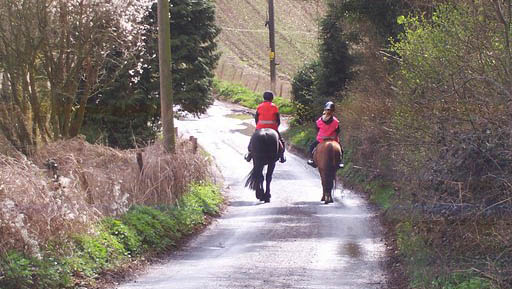Have Some Horse Sense on the Road!
Vulnerable Road Users: The roads are there for everyone to use and as advanced drivers and riders we have a duty to make sure we share them safely.
IAM RoadSmart
In our primarily rural area, among the vulnerable road users we are most likely to encounter are horses and their riders. In fact, most horse riders would prefer not to ride on the roads. However, a lack of off-road access means using roads is a necessity for many riders. Riders have the same right to be on the road as motorists, cyclists or any other user group. With a bit of understanding and consideration on all sides, there’s room for everyone to use the roads in harmony and safety.
At our February meeting, OAD members were given a presentation by Alan Hoscox of the British Horse Society which explored the sometimes uneasy relations between horse riders and motorists. In particular, Alan introduced the BHS Dead Slow campaign.
It’s important to understand that horses are prey animals and their usual response to danger is flight. This means that however well-trained and calm a horse normally is, they can still be unpredictable and frightened by something they perceive as a threat. This is their natural instinct and means a horse’s reaction to a threat is to try to escape the situation. A horse’s range of hearing is greater than a human to higher frequencies - (over 33kHz in the horse compared with under 20kHz in humans - although a horse may not be able to hear the lowest frequencies audible to humans.
Horses use their hearing for three primary functions: to detect sounds, to determine the location of the sound and to provide sensory information that allows the horse to recognise the identity of these sources. Horses will always react to unexpected or loud noises.
This is why it’s vital to always pass horses slowly and with plenty of room.
In some instances, the rider may be busy keeping control of their horse and not able to acknowledge your consideration, but they will be very grateful to you.

What should drivers do?
- On seeing a horse on the road in front of you - whether ridden, driven or led - please slow down to a maximum of 15mph and be prepared to stop if necessary.
- Heed a rider’s or carriage driver’s signal if they ask you to stop or slow down.
- Look out for a rider or carriage driver's signal to turn and wait for them to do so safely before continuing your journey. Wait until they are fully off the road before continuing.
- If the horse shows signs of nervousness as you get closer, please stop and/or turn the engine off and allow them to pass.
- Please don’t start your engine, or move off again until horses are well clear of the rear end of your vehicle.
- If you are approaching horses on the road and would like to overtake them, please approach slowly, or even stop to give them time to find a gateway or other place off the road where there will be enough space between the horse and vehicle to allow you to pass safely.
- Please be patient. Most equestrians will do their best to reassure their horses and will allow you to pass as soon as safe to do so.
- The safest place for the rider’s hands is on the reins, so they may only be able to nod their thanks to you – but please do be assured that they will be very grateful for your consideration.
Alan Hoscox was at pains to stress the Dead Slow campaign doesn’t simply point the finger of blame at motorists. Sensible behaviour by riders is just as important in avoiding injuries and deaths. So, as well as aiming to raise awareness among drivers about the dangers that arise when horses and motor vehicles share the road, BHS also offer riders a Ride Safe Assessment to raise their awareness as well.
As Alan pointed out, compared with other countries, the UK offers relatively few opportunities for riders to enjoy their riding away from busy roads. And the network of existing bridleways is under threat; those that are not used regularly are likely to be closed. In 2000, the Countryside and Rights of Way Act was introduced in England and Wales. Section 53 of the Act provides for a cut-off date of 1st January 2026, which means that many historical routes for horse riders will disappear if they are not formally recorded as a bridleway or restricted byway beforehand.
More horses on our roads will mean that it becomes even more important for motorists to behave towards them safely and with real understanding.
Many thanks to Alan for such an instructive presentation, delivered with enthusiasm and conviction. Thanks also to Assistant Secretary, Lisa Collins, for organising it all.
The most vulnerable road users are pedestrians, particularly children, older or disabled people, cyclists, motorcyclists and horse riders. It is important that all road users are aware of the Code and are considerate towards each other.
The Introduction to the Highway Code, 2019
If I see a horse on the road;
Then I will....
-- Slow down to a maximum of 15mph
-- Be patient, I won't sound my horn or rev my engine
-- Pass the horsewide and slow - at least a car's width, if possible.
-- Drive slowly away